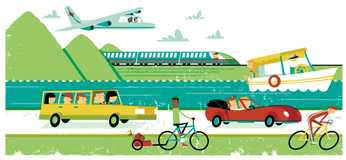Transport evolution / Global
Take the high road
In this issue’s transport survey we highlight some innovative developments in the car, aviation, bike, yacht and train industries. But in general, travelling is still a chore rather than a pleasure. It’s time operators and policymakers woke up.

It’s shaping up to be a mixed year for the transport sector. What looked set to be a 2011 calendar packed with industry firsts, high-speed breakthroughs, mega-orders and sector-changing infrastructure initiatives is now looking ho-hum at best. We were hoping to be flying around Asia on Boeing’s new 787 by now but pilots for launch customer ANA have only just settled into the cockpit and the first aircraft should start shuttling passengers around Japan by year end. In the US trainspotters hoping to glimpse the first tracks being laid for new high-speed rail services will have to put away their anoraks and fold up their deck-chairs for a while as the Obama dream of creating a shinkansen-style transport infrastructure is parked on a weedy siding somewhere in suburban DC. And in London we were hoping its new pay-and-ride bicycle scheme would have been matched with more dedicated lanes and a comprehensive cycling strategy but sadly most two-wheel commuters have a daily battle with belching, nasty lorries and bus drivers’ blind-spots.
While some grand projects that aimed to make travel faster and friendlier might be on life support, others are apace and will radically alter the way we navigate cities, cross continents and bound over oceans. In Switzerland, teams boring through the Alps met in the middle marking an important phase in both the creation of the world’s longest tunnel and a link that will dramatically cut rail journey times between Italy and northern Europe. On the streets Nissan’s Leaf finally saw consumers get behind the wheel to prove that electric vehicles are more than just a marketing fad. And a dear old aviation classic, the 747, got a new coat of paint: a longer fuselage and various performance enhancements that will see Boeing attempt to woo airlines who find Airbus’s A380 too cumbersome for their needs.
Engineers, designers and policy-makers should all be applauded for making aircraft quieter and more fuel efficient and commuter stations easier to use but the fact remains that travel tends to be a drag. In a drive to find efficiencies at every turn, most journeys are generally charmless experiences in bland environments populated by service staff too worn down to even attempt a smile, let alone refill your glass. Makers of planes, trains and automobiles look to emerging markets for growth but if they don’t work more closely with the operators of their vehicles to devise more pleasurable ways to get to the office or hop around the planet, they’ll soon find the beaming masses in Indonesia growing just as jaded as suffering travellers in the US.
This means that Hitachi and Siemens need to work with state bureaucrats to show them what life on the rails can really be like. Bombardier must engineer a complete travel experience to show everyone from airport operators to airline CEOs how wonderful mid-haul jaunts can be on their forthcoming CSeries. Then there’s the cruise industry, which needs to start building elegant ships rather than floating suburban malls – but we’ll save that for another issue.


